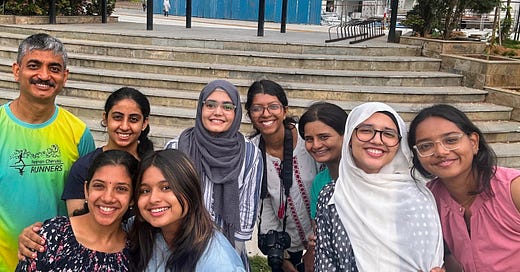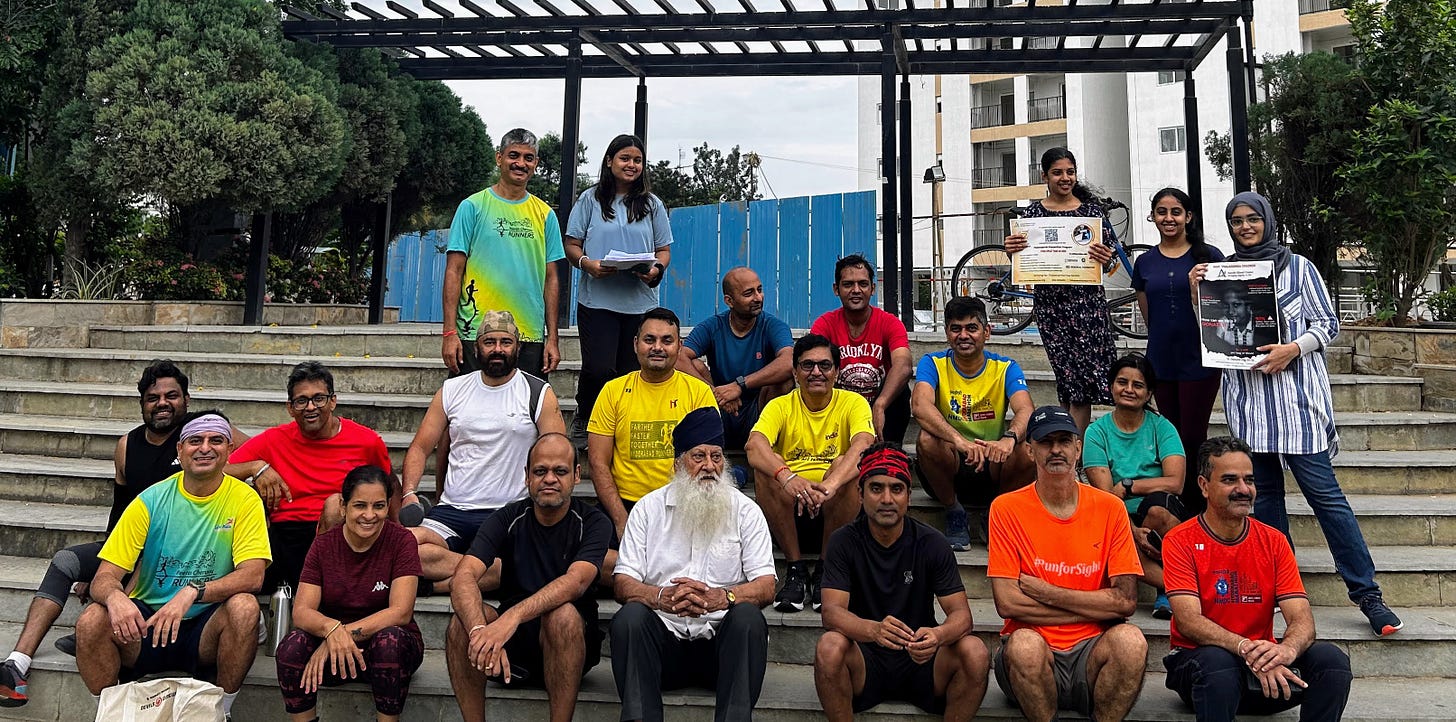Talking about BTS, this video has become my favourite example of repurposing content demonstrating a keen sense of creativity and marketing prowess. It also shines light on hitherto hidden superstars like the movie director or the choreographer or even director of photopgraphy and crew.
Not surprisingly, some of the best content coming out of Paris Olympics is from elite athletes cum content creators, influential content creators sponsored by major digital platforms or even self-supported social media influencers. Everybody has now ACCESS to Behind the Scenes.
Before we dive in further, if you are reading for the first time, please subscribe for a weekly email discussing Running Platform Marketing Life.
AND if you are a friend of the RPML, do share it with others. You can add more of your friends to the Community of Platform’ed by using the following link.
Do share your feedback on this newsletter if you have not done it yet.
DTW
During the Week, Shailesh Chandra, MD of Tata Motors Passenger Vehicle and Tata Passenger Electric Mobility Ltd, at the launch of the Tata Curvv.ev, hinted at a potential collaboration with the Tata Group to bolster the automaker's supply chain security . The announcement comes exactly a week after the Tata Group's unveiling of a chip manufacturing plant in Assam. Chandra's statement suggests that Tata Motors is keen to leverage the group's foray into semiconductor manufacturing to mitigate supply chain risks, which have been a major challenge for the automotive industry in recent years. By securing a stable and reliable chip supply, Tata Motors could potentially improve production efficiency, reduce costs, and enhance its competitiveness in the market.
Supply Chain Management (SCM) is the intricate science of overseeing and optimizing the flow of materials, information, and finances as they journey from suppliers to consumers. In today’s rapidly evolving business landscape, digital platforms have become vital in streamlining these processes. These platforms enable seamless coordination, real-time visibility, and enhanced collaboration across various supply chain stages, from procurement to delivery. By integrating and automating complex logistics, platforms not only reduce inefficiencies and costs but also enhance agility and responsiveness, ensuring that supply chains remain resilient and competitive in an increasingly dynamic global market.
To use the analogy of BTS discussed at the start of the newsletter, supply chain management is the backstage magic that makes the economic stage shine. Usually consumers are captivated by the end product – whether it's a smartphone, a car, or a concert ticket – while the complex network of suppliers, manufacturers, transporters, and retailers that bring it to life often goes unnoticed. It's about ensuring the right products are in the right place at the right time, in the right quantity, and at the right cost.
From raw materials to finished goods, supply chain management orchestrates a symphony of activities. It's the unseen force that drives global economies, powering industries from technology to agriculture. Yet, despite its critical role, it often remains in the shadows, overshadowed by marketing, sales, and product development.
“You do not rise to the level of your goals. You fall to the level of your systems.” James Clear
The COVID-19 pandemic has drastically transformed the global supply chain landscape, compelling businesses to reimagine their logistics operations and adapt to new challenges. Central to this transformation is the growing role of digital platforms in enhancing supply chain efficiency and resilience. Understanding logistics and platform dynamics can be broken down into three critical dimensions: Coordination across Modes and Geography, Crowdsourcing of Assets and Services, and the Provision of Multiple Services through Infomediaries and Social Media. Each of these facets plays a crucial role in managing supply chains in a post-COVID world.
Coordination across Modes and Geography:
Coordination across modes of transportation and geographical boundaries has emerged as one of the most significant value-creating activities facilitated by digital platforms. In a post-COVID world, where supply chains have become more complex and fragmented, platforms enable seamless point-to-point deliveries within specific geographies. These deliveries are then aggregated across different modes of transport, leading to substantial savings in cost and time. Digital platforms also play a pivotal role in reducing the burden on manufacturers and logistics partners by providing intermediaries that facilitate the handover of goods at intermediate points. This has proven essential in minimizing disruptions and maintaining the flow of goods, especially in regions where supply chains were severely impacted by the pandemic.
Crowdsourcing of Assets and Services:
Crowdsourcing of assets, such as delivery vehicles and warehouse space, has unlocked significant value for both suppliers and buyers. The pandemic accelerated the growth of Direct-to-Consumer (D2C) brands, many of which have relied heavily on last-mile delivery partners like ShadowFax to reach their customers. These platforms not only provide delivery services but also offer warehousing, payment collection, and reverse logistics, thereby enabling businesses to scale rapidly without the need for significant capital investment in physical infrastructure. The ability to crowdsource assets has been particularly beneficial in meeting the surge in e-commerce demand during the pandemic, ensuring that products reach consumers efficiently and cost-effectively.
Multiple Services through Infomediaries and Social Media:
The provision of multiple services through related and unrelated infomediaries, coupled with the power of social media, has enhanced visibility into logistics operations in real-time. Startups and digital platforms are increasingly focusing on solving critical issues, such as driver-related problems, which in turn improve working conditions and lead to a more reliable delivery system. The integration of social media allows companies to engage with customers directly, gather feedback, and provide timely updates on the status of their orders. This increased visibility not only improves customer satisfaction but also enables businesses to respond swiftly to potential disruptions, a capability that has become invaluable in the uncertain post-COVID environment.
In conclusion, the post-COVID era has underscored the importance of digital transformation in managing supply chains. Platforms that facilitate coordination across modes and geographies, enable crowdsourcing of assets, and offer multiple services through infomediaries and social media have become indispensable. As businesses continue to navigate the complexities of a global supply chain disrupted by the pandemic, the role of these platforms will only grow in significance. By leveraging these digital tools, companies can build more resilient, efficient, and customer-centric supply chains, better equipped to withstand future challenges.
OTW
Over the Weekend, Aru and her classmates studying at St Francis College for Women, Hyderabad invited the Peerancheruvu Runners and Blood Donation community at PBEL City to participate as background actors for their class project short film. They have embarked on a meaningful journey that goes beyond the confines of their academic curriculum, channeling their efforts into raising awareness about Thalassemia through a short film. This project exemplifies the power of experiential learning, where students not only apply theoretical knowledge but also develop a deep sense of empathy and social responsibility. In the heart of this project lies a unique opportunity for Aru and her peers to engage directly with the community.
This collaborative effort with other community stakeholders serves as a powerful metaphor for the unity and collective action needed to combat Thalassemia, while also highlighting the importance of community involvement in addressing social issues.
I believe that through their active participation, Aru and her classmates are experiencing firsthand the challenges and rewards of service leadership. This project is teaching them that leadership is not just about guiding others, but about serving a greater cause with compassion and commitment.
Our good friends at Aarohi Blood Bank led by Dr Aditi Kishore and Dhiraj Kaveri have been doing a yeoman service to the cause of voluntary blood donation. I would like to encourage you to start a bond with a Thalassemia and Leukemia Child for regular blood donation. You can join the mission to support Blood Donation for Thalassemia Patients by signing up the Blood Bridge initiative by Blood Warriors
You can be a hero too!
I Love You
Shailendra





